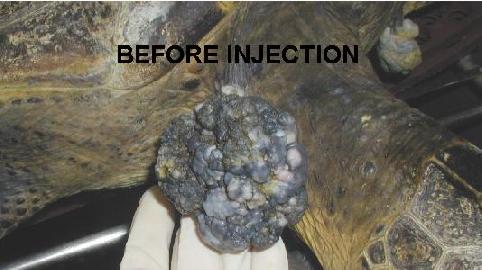DERMEX TRIALS
Unpublished report, June 2002
Dr. Robert A. Morris1 and George H. Balazs2
| 1morrisr005@hawaii.rr.com, Makai Animal Clinic, 420 Uluniu Street, Kailua, Hawaii 96734, USA |
| 2gbalazs@honlab.nmfs.hawaii.edu, National Marine Fisheries Service, Southwest Fisheries Science Center, Honolulu Laboratory, 2570 Dole Street, Honolulu, Hawaii 96822-2396, USA |
A preliminary trial has been conducted with an experimental drug called Dermex. The objective of this work was to evaluate the product's ability to remove fibropapillomas on green turtles by a non-surgical technique under clinical conditions in Hawaii. The results are presented in this short report. Please contact the authors for additional information.
The following notes describe the results of our experirmentatation using Dermex injections and "cream" on green turtle fibropapilloma tumors in Hawaii. These observations are based mainly on a stranded green turtle (10.5 kg, 47.4 cm SCL) with multiple large and small tumors held for rehabilitation by the National Marine Fisheries Service.
-
The injection material is thick and difficult to infuse into dense tumors. At least an 18 ga. needle must be used.
-
The cream is thick, dry and virtually impossible to apply. It does not seem to have any effect on the tumors.
-
Injections seem to be effective in dissolving large tumors (greater than 3 cm.). The effect on smaller tumors is variable.
-
Injections at the base of a large tumor seem to be effective and much easier to administer.
-
Complete necrosis of the tumor takes approximately 3-4 weeks.
-
Deep craters remain after tumor necrosis. These become covered with a soft tissue "scab". The craters may represent sub dermal tumor affected tissue.
-
Healing in captivity is still taking place after 2 months. Scabs are slowly peeling off revealing healthy tissue beneath.
-
Eye tumors are difficult to inject because of the large needle size needed due to the thickness of the Dermex and pain associated with the injection.
-
Normal tissue did not seem to be affected by sub cutaneous injections of Dermex a week after administration.
-
Intravenous injection of 3 cc of Dermex in a turtle designated for euthanasia did not seem to have any adverse effects after 24 hours.
-
The most effective dosage of Dermex is yet to be determined. The 0.5 cc per cm. of tumor mass was used as a guideline.
-
Blood chemistries and blood counts on the turtle used in this experiment remained stable over time. The turtle gained weight and continued with a good appetite.
-
Several turtles with large tumors captured from the wild received injections and were released a short time later in areas that are regularly sampled for research purposes.
Continuing investigations:
-
Inject several large tumors on other turtles and hold for observations.
-
Inject some jaw hinge tumors and glottis tumors.
-
Try intravenous injection on a heavily tumored turtle and observe its effect on the tumors.
-
Inject normal skin and determine its effect over a longer period of time.
-
Conduct studies to determine the "most effective dose".
-
Develop alternate delivery systems.
-
Develop a cream with proper salve characteristics.
Dermex may have a place in the treatment of solitary fibropapilloma tumors in sea turtles. This is not a practical cure since the cause of the tumors has yet to be determined. There are thousands of free ranging turtles in Hawaiian waters with these tumors however, Dermex could lengthen the life of selected turtles and provide an alternative treatment (instead of surgery) of a less invasive nature suitable for field use.
The following photographs illustrate the effect of Dermex on four tumors over time.
All phtotgtaphs courtesy George H. Balazs and Dr. Roberrt Morris.

Tumor 1, Right Neck, Photo A

Tumor 1, Photo B

Tumor 1, Photo C

Tumor 1, Photo D

Tumor 2, Right Hind, Photo A

Tumor 2, Photo B

Tumor 2, Photo C

Tumor 3, Left Hind, Photo A

Tumor 3, Photo B

Tumor 3, Photo C

Tumor 4, Left Front, Photo A

Tumor 4, Photo B

Tumor 4, Photo C
 Sickbay
Sickbay
 Table of Contents
Table of Contents
Last modified 03/02/08
Send comments or corrections to webmaster@turtles.org













 Sickbay
Sickbay Table of Contents
Table of Contents